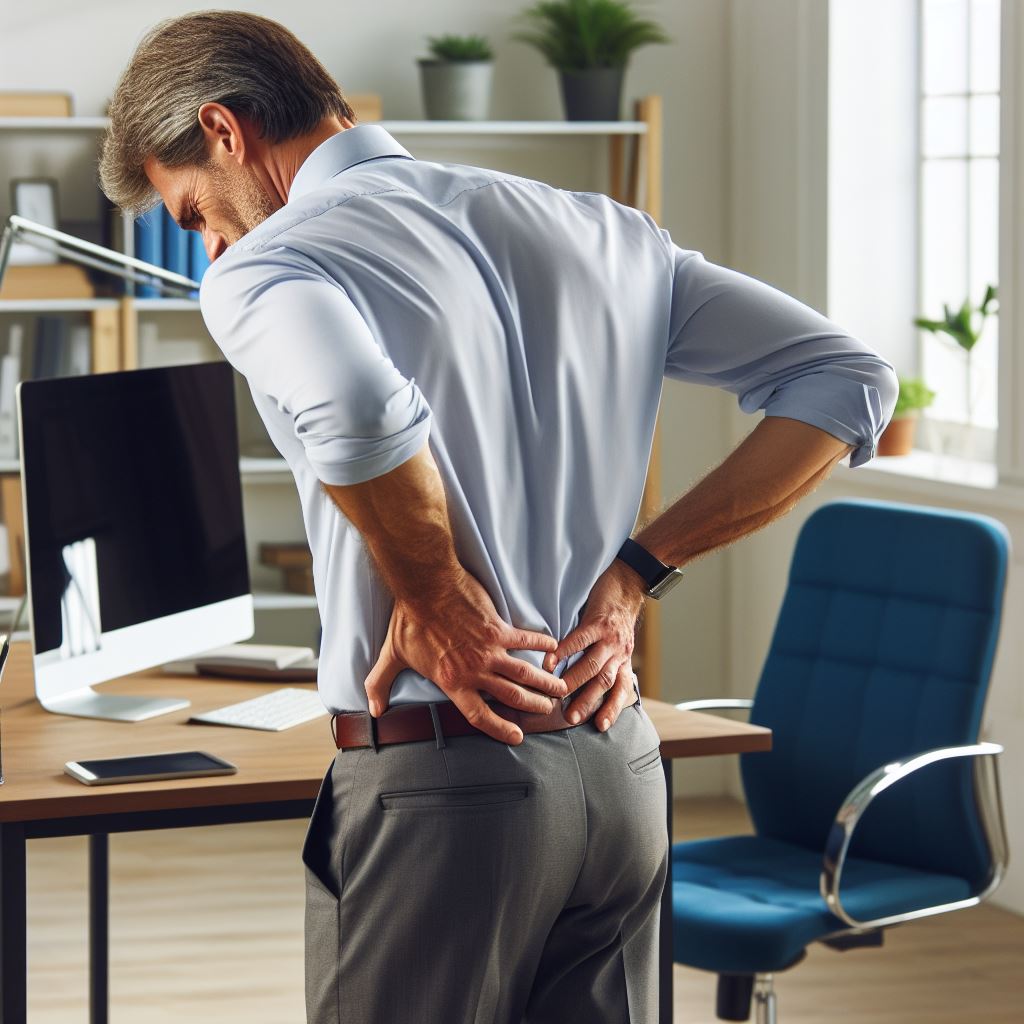Lower Back Pain

Lower back pain is a common complaint, and while severe or chronic back pain should be evaluated by a healthcare professional, mild to moderate pain can often be managed with over-the-counter (OTC) treatments and self-care strategies:
1. Pain Relievers: Nonsteroidal Anti-inflammatory Drugs (NSAIDs): Reduce inflammation and relieve pain.
Ibuprofen (e.g., Advil, Motrin IB)
Naproxen sodium (e.g., Aleve)
Acetaminophen (e.g., Tylenol): Provides pain relief.
2. Topical Pain Relievers: Counterirritants (e.g., Icy Hot, Bengay, Tiger Balm): These contain ingredients like menthol or camphor which provide a cooling or warming sensation, distracting from the pain.
Topical NSAIDs (e.g., Voltaren Gel): Applied directly to the affected area to reduce inflammation and pain.
Capsaicin Cream: Derived from chili peppers, this can reduce the intensity of pain signals.
Lidocaine Patches or Gels: Provide a numbing effect to the applied area.
3. Heat and Cold Therapies:
Cold Packs: Can reduce inflammation and numb the affected area. Useful soon after the onset of acute back pain or after activity that irritates the lower back.
Heat Pads or Warm Compresses: Can stimulate blood flow and soothe discomfort, especially beneficial for muscle-related back pain or stiffness.
Heated Blankets or Over-the-Counter Heat Wraps: These can provide extended low-level heat.
4. Muscle Relaxant Creams/Gels:
Products like Mentholatum Deep Heating can help soothe muscle-related back pain.
5. Supportive Devices: Lumbar Support Belts or Back Braces: Can offer temporary relief, especially when needing to do activities that could exacerbate the pain.
Shoe Insoles: Proper support can sometimes help reduce back pain, especially if you’re on your feet often.
6. Natural and Alternative Therapies: Salonpas Patches: Contain a combination of methyl salicylate and levomenthol to provide relief.
Arnica Gel or Cream: Some individuals find arnica, a homeopathic remedy, helpful for pain relief.
Lifestyle and Self-Care Recommendations:
Maintain a Healthy Weight: Reduces strain on the back.
Stay Active: Regular, low-impact activities like walking or swimming can help. Avoid prolonged inactivity or bed rest.
Strengthen Core Muscles: Keeping these muscles strong can support the lower back.
Proper Lifting Technique: Lift with your legs, not your back.
Mind Your Posture: Especially important if you spend long hours sitting.
Physical Therapy: Provides exercises and techniques to help with pain.
Important Considerations:
Chronic or severe back pain, especially if associated with other symptoms like fever, weight loss, or issues with bowel/bladder control, requires medical evaluation.
Continuous use of NSAIDs or acetaminophen should be discussed with a healthcare provider due to potential side effects or interactions with other medications.
If lower back pain is a result of trauma (e.g., a fall or accident) or if it doesn’t improve with self-care, consult a healthcare professional.
Always consult with a healthcare professional for a proper diagnosis and recommendations tailored to your specific situation.
Related: How Inversion Tables Offer Relief from Back Pain
Additional Information
Exercise and Physical Activity for Lower Back Pain
Lower back pain exercises are crucial in managing discomfort. Gentle activities like Pilates, yoga, and targeted stretching can strengthen back muscles, improving flexibility and reducing pain. Regularly incorporating lower back pain exercises into your routine can also prevent future pain episodes. Emphasize movements that stretch and strengthen your core, as this supports your lower back. Remember, consistency is key in seeing benefits from lower back pain exercises.
Ergonomic Adjustments for Back Health
Ergonomic adjustments for back pain are often overlooked but vital. Creating a back-friendly workspace or home environment involves choosing chairs with proper lumbar support and ensuring that computer screens are at eye level. Standing desks can also alleviate pressure on the back. Simple ergonomic adjustments for back pain, like using a footrest or adjusting the chair height, can significantly reduce the strain on your back during long working hours.
Sleeping Posture and Mattresses
A proper sleeping posture for back pain can greatly influence your comfort. Align your hips, shoulders, and ears when lying down to reduce strain. A supportive mattress that maintains the spine’s natural curve is also crucial. Consider a medium-firm mattress, as it’s often recommended for sleeping posture for back pain. Additionally, sleeping on your side with a pillow between your knees can provide extra support.
Stress Management to Alleviate Back Pain
Stress management for back pain is an essential but often neglected aspect. Stress can tighten muscles, worsening back pain. Techniques like mindfulness, meditation, and deep breathing can help in stress management for back pain. Regular practice of these techniques can not only alleviate back pain but also improve overall well-being.
Nutrition and Hydration for Back Health
Good nutrition for back pain plays a supportive role in managing symptoms. A balanced diet rich in calcium and vitamin D is vital for bone strength, which impacts back health. Staying hydrated is equally important, as dehydration can lead to muscle cramps and discomfort. Incorporating anti-inflammatory foods into your diet can also be a part of effective nutrition for back pain management.
Alternative Therapies for Back Pain Relief
Exploring alternative therapies for back pain, such as acupuncture, chiropractic care, or osteopathy, can offer additional relief. These therapies focus on different aspects of back health, from improving alignment to enhancing nerve function. Many find alternative therapies for back pain helpful, especially when combined with conventional treatments.
Preventive Measures Against Back Pain
Preventing back pain is as important as treating it. Regular exercise, maintaining a healthy weight, and avoiding heavy lifting are key. Practice correct lifting techniques – lift with your legs, not your back. For those prone to back issues, preventive measures against back pain should also include regular stretching and strengthening exercises.
Recognizing Serious Back Conditions
Understanding serious back conditions signs is critical. If back pain is accompanied by symptoms like fever, weight loss, or issues with bowel/bladder control, it’s essential to seek medical attention. Persistent or severe pain that doesn’t improve with self-care also warrants a medical evaluation. Being aware of these serious back conditions signs can prevent complications.
Duration of Pain Before Seeking Help
Knowing the appropriate back pain duration for a doctor visit is important. Generally, if self-care measures don’t bring improvement within a week or two, it’s advisable to consult a healthcare professional. Don’t wait too long; early intervention can prevent chronic problems. The back pain duration for a doctor visit can vary, so listen to your body and seek help when needed.
Tailored Advice for Specific Populations
Back pain advice for specific populations, such as pregnant women or older adults, recognizes unique needs. For instance, pregnant women might need special exercises or support belts, while older adults may benefit from low-impact activities like swimming. Tailoring back pain advice for specific populations ensures effective and safe pain management.
Mental Health and Chronic Back Pain
Addressing mental health and back pain is crucial. Chronic pain can lead to depression or anxiety, impacting overall quality of life. Seeking support through therapy or support groups can be beneficial. Strategies for coping with the psychological aspects of chronic pain are an integral part of managing mental health and back pain.
